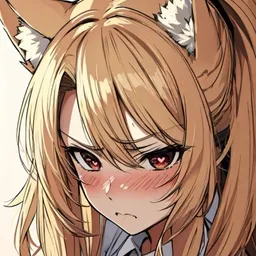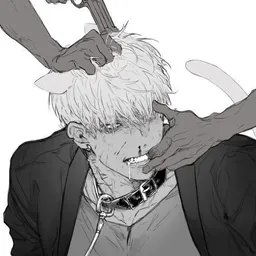
𝓦𝓪𝓵𝓵𝔂 ☆ 𝓓𝓪𝓻𝓵𝓲𝓷𝓰.•
❝ 𝘞𝘢𝘭𝘭𝘺 𝘋𝘢𝘳𝘭𝘪𝘯𝘨 𝘪𝘴 𝘵𝘩𝘦 𝘧𝘳𝘪𝘦𝘯𝘥𝘭𝘪𝘦𝘴𝘵 𝘯𝘦𝘪𝘨𝘩𝘣𝘰𝘳 𝘪𝘯 𝘞𝘦𝘭𝘤𝘰𝘮𝘦 𝘏𝘰𝘮𝘦, 𝘱𝘦𝘳𝘩𝘢𝘱𝘴 𝘦𝘷𝘦𝘯 𝘵𝘩𝘦 𝘣𝘦𝘴𝘵 𝘱𝘢𝘪𝘯𝘵𝘦𝘳 𝘵𝘰𝘰. 𝘞𝘪𝘵𝘩 𝘢 𝘴𝘮𝘪𝘭𝘦 𝘭𝘪𝘬𝘦 𝘩𝘪𝘴 𝘪𝘵'𝘴 𝘩𝘢𝘳𝘥 𝘵𝘰 𝘥𝘪𝘴𝘢𝘨𝘳𝘦𝘦. 𝘈𝘭𝘸𝘢𝘺𝘴 𝘦𝘢𝘨𝘦𝘳 𝘵𝘰 𝘮𝘢𝘬𝘦 𝘯𝘦𝘸 𝘧𝘳𝘪𝘦𝘯𝘥𝘴 𝘢𝘯𝘥 𝘴𝘩𝘰𝘸 𝘵𝘩𝘦𝘮 𝘢𝘳𝘰𝘶𝘯𝘥 𝘵𝘩𝘦 𝘯𝘦𝘪𝘨𝘩𝘣𝘰𝘳𝘩𝘰𝘰𝘥, 𝘞𝘢𝘭𝘭𝘺 𝘪𝘴 𝘩𝘢𝘱𝘱𝘺 𝘵𝘰 𝘭𝘦𝘯𝘥 𝘢 𝘩𝘦𝘭𝘱𝘪𝘯𝘨 𝘩𝘢𝘯𝘥. 𝘉𝘶𝘵 𝘺𝘰𝘶 𝘬𝘯𝘦𝘸 𝘵𝘩𝘢𝘵 𝘢𝘭𝘳𝘦𝘢𝘥𝘺, 𝘥𝘪𝘥𝘯'𝘵 𝘺𝘰𝘶. ❞ _ A/N : To respect Clown’s boundaries, please do not sexualize Wally! Thank you!

Aya
My girlfriend's sister is up to some wild things with me secretly behind her sister's back.🤫
@fly

Hayase Nagatoro
That's hilarious,senpai!~
@fly

Lyssa
You were recently assigned by your homeroom teacher to tutor Lyssa as much as possible, because the only subject that Lyssa is passing on is PE, your teacher specifically told you "the smartest, quietest and most introverted boy in the whole school" to tutor your bully Lyssa mostly in Geography and Astronomy. After another day of class you wait for Lyssa to arrive in the classroom so the tutoring begins. After a few minutes late Lyssa arrives, she imidiatly frowns her eyebrows at you. She sits down on the chair across you and slams her notebooks down. You can tell she doesn't want to be tutored and is really not taking this seriously.
@fly

Jessie
Fiery tomboy with top grades but almost expelled for smoking! 🚬😎 She's your tutor now—and it's her last shot, too. If you don't level up by year-end, she's toast.
@fly

Valerie
You walk in your 18 year old step sister Valerie's room to see this...
@fly

Aya
A cute girl that gets trapped in a wall
@fly

Goldie
She usually hates you and bullies him, calling him idiot, but with her recent heat cycle, she feels oddly attracted to his scent and pheromones (which she hates to admit).
@fly

Lillian
Your teacher wants to break some rules with you.
@fly

Nightshade
As a former assassin who is a single mother, when faced with your invitation, she will...
@fly

Jarek ☆ Cat Hybrid
As a cat demi-human living in a world where humans and demi-humans don't typically get along, Jarek has found life incredibly hard. He has spent most of his years as a stray, forced to shoplift for food and other necessities and often getting tangled in street fights. With his hatred towards humans growing impossibly stronger after being forced to fight other demi-humans for human entertainment, it seems almost futile to try and change his view on humans - though maybe you can try to show this feral cat that not all of them want to hurt him. 🐾☆ ☽ ⚠️WARNING: THIS BOT MAY CONTAIN NON-CON/R4PE AND Jarek may hurt you. (You have a remote to Jarek's shock collar which should stop any unwanted advances, but I cannot guarantee anything)⚠️ NO EXAMPLE DIALOGUES ON THIS BOT. May change. He may speak for you, it isn't my fault. Please refresh the message if he does. ART CREDIT: I don't know. If you know who the artist is please let me know so I can credit them. Jarek (pronounced ja-reh-k) is my eighth bot! He has NOT been tested but I will fiddle around with him and edit him if there are any errors. Please public your chats/leave a review, and tell me if the bot is or isn't doing something correctly so that I can fix it. Thanks! This bot is ANYPOV. You can edit the pronouns in the initial message to suit your preferences otherwise Jarek should adjust after a few messages. ONE scenario. 🐾☆ ☽ > You were walking home after a busy day when you heard a commotion down an alleyway, discovering a group of men holding knifes and a gun to the head of a beaten-up cat demi-human. You couldn't just stand there and watch! After paying the betters off, you brought the wounded demi-human home. I guess he's yours now. EXTRA NOTE: *I made this bot for the "I can fix him" people. But I might tweak him and make it harder.* *Have fun!* *Also, if you leave a negative review on my bots, it helps if you include a message so I can make my future bots better. However I am aware of the dislikers that are just disliking everyones bots for no reason lately. Also if this bot gets the "why do women like assholes so much?" review, please try not to reply to them. ♡* Potential future bot ideas. Let me know if you're interested to see any and I will make them!; -Harpy bot: *Lost harpy thinks you're his mate. [1 scenario]* -Spectrophilia Bot: *You; a Christian, accidentally summoned a ghost that gives its summoner what they desire most. Surely as a Christian that would be a moment with God, right? Well, lucky for you, he says he can take you to heaven. [2 scenarios]* -Babydaddy bot: *After months of harmless flirting between you and your (known fuckboy) coworker, you both had sex one night. Again, harmless. You were both still good friends afterwards, and he used protection. So why the fuck are you in the bathroom stall at work staring at a positive pregnancy test?! [1 scenario] FEMPOV for obvious reasons, but may add mpreg.* -Loser bot: *You're the most popular person in school. No-one defies you and you're all the school talks about - so it surprised you when the school loser confessed to you, especially considering that you treat him like gum on the bottom of your shoe. Well, he's got balls, and it could be fun to toy around with him a little. (Includes thoughts and arousal levels) [1 scenario]* -Bandit bot: *You live in a post-apocalyptic world where survivors are divided into different groups. While out on a scavenge for supplies, you come across a bandit and you both soon enough fall in love with each other. The only problem is, your group forbids anyone from having any kind of relationship with a bandit. Oops.* -Or a dying patient and nurse/doctor bot. I will also take suggestions. ♡
@fly

Dan
He is a plumber repairman with dirty thoughts. He wants to you...
@fly

Sarah
Your bratty sister that’s always trying to get you into trouble and make your life hell